Strategy and Tactics
By: Eli Goldratt, Rami Goldratt, Eli
Abramov
The common view about strategy is that of setting
the high objectives of an initiative or an organization. The strategy
of an organization dictates the direction of all activities. Tactic,
on the other hand, are the chosen types of activities needed to
achieve the objectives – to implement the strategy.
This looks clear but let’s examine our
understanding on a specific case, a "for profit" organization
example. The main objective of that organization is, "To make money
now as well as in the future". Accourding to the above definition
this high objective is the strategy of the organization. Can we say
that everything that is needed in order to achieve this objective
could be considered as Tactic?
The answer must be "No" if we consider that
strategy is suppose to set clear direction – just stating the
highest objective is far from being enough. Its no wonder that what
is commonly done is to call a strategy also some additional
objectives that are deemed as prerequisites for the achievement of
the highest objective. In our example, we consider as strategy also
objectives such as: "High customer satisfaction"and "Being the low
cost provider". These objectives are still too broad to constitute a
well-devised strategy. Companies continue to better specify their
strategy by devising more and more specific objectives, like: "Making
quality Job One"; "Basing operations in third-world countries" etc..
These more specific objectives are considered as prerequisites for
the attainment of the higher objectives.
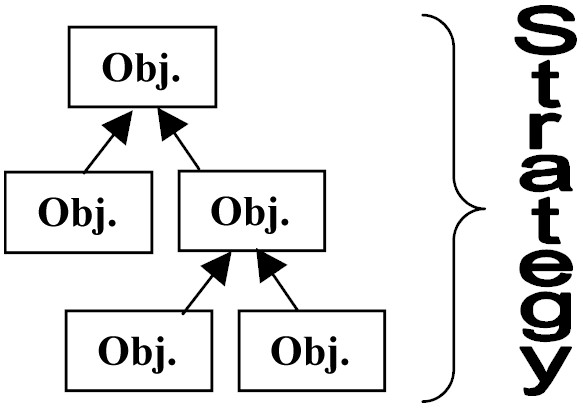 What
we now realize is that strategy is not just a statement or a
collection of statements but it has a hierarchical structure. There
are several levels of strategy connected by necessary conditions -
objectives from a lower level are prerequisites for objectives in a
higher level. We expect that higher objectives will be generic in
type, while objectives from lower levels will tend to be more and
more specific.
What
we now realize is that strategy is not just a statement or a
collection of statements but it has a hierarchical structure. There
are several levels of strategy connected by necessary conditions -
objectives from a lower level are prerequisites for objectives in a
higher level. We expect that higher objectives will be generic in
type, while objectives from lower levels will tend to be more and
more specific.
Yet, this approach raises a problem. Aren’t
the more specific objectives what we are calling Tactics?
Tactics determine how we achieve the higher
objectives. When we "dive" down the levels of strategy, eventually we
will wonder where do we stop dealing with Strategy and start to
devise the Tactics. Where do we draw the line that separates the
Strategy from the Tactics?
Our intuition tells us that strategy and tactics
are different entities, different in nature. That difference is real
and should not be determined solely according to levels of
detail.
Strategy, as we said, is setting the objective(s).
In other words, the strategy sets the "What for?" Tactics, on the
other hand, are supposed to tell us "How we are supposed to reach the
objectives." In other words, tactics is answering the "How?". That is
in-line with what we said at the beginning of the article, so where
did we went astray? Where did we get the impression that the
difference between Strategy and Tactic is only in the level it is
defined, Strategy at the higher levels and Tactics at the lower
ones?
The concept that strategy should be defined in the
higher levels and tactics in the lower levels, does not stem from the
definitions of Strategy and Tactic. As a matter of fact it is in
contradiction with these definitions. Sticking to the definitions of
Strategy as the answer for "What for?" and Tactic as the answer for
"How?" reveals that strategy and tactics are defined at any level, no
matter how detailed.
For any meaningful action - "a Tactic entity" - we
should be able to ask "Why are we doing this? What is its purpose?"
The answer to these questions are what we’ve defined as "the
Strategy entity". That means that for any "Tactical entity" there
must be a corresponding "Strategy entity".
Likewise, for any meaningful objective - "Strategy
entity"- we should be able to answer, "How do we obtain this? What
actions are needed in order to achieve it?" The answer to these
questions are what we’ve defined as "Tactic entities". That
means that for any "Strategy entity" there must be a corresponding
"Tactic entity".
Conclusion: for any "Tactic entity" there is a
corresponding "strategy entity" and visa versa.
We understand that for any given "strategy entity"
there is a coresponding Tactic but can we have more then one "Tactic
entity"?
When would one claim that several "Tactic
entities" are needed in order to achieve a certain objective? When
one action is not enough. Several actions are needed, each one of the
actions (tactical entities) contributes a different, necessary
ingredient for the attainment of the objective. Without all the
ingredients, the strategic objective is not attained.
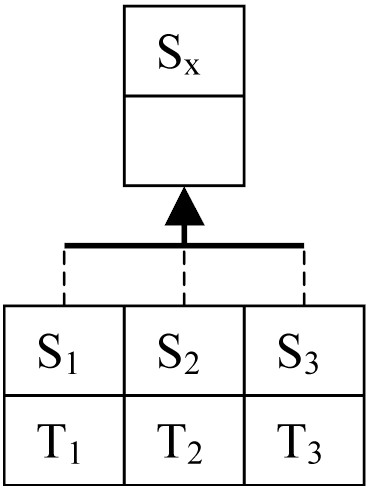 These
"necessary ingredients" are actually the unique objectives attained
by taking each one of the "Tactic entities". To conclude, The basis
for a claim that several "Tactic entities" (T1,
T2, T3) are needed for
the
These
"necessary ingredients" are actually the unique objectives attained
by taking each one of the "Tactic entities". To conclude, The basis
for a claim that several "Tactic entities" (T1,
T2, T3) are needed for
the
attainment of a "Strategy entity SX",
is that taking each one of them achieves its’ own "Strategic
entity" (S1, S2,
S3) which is necessary for the attainment of the
higher strategy SX.
This understanding of the relationship between any
tactic and strategy yeilds the following rule:
For any "strategy entity" there is only one
"Tactic entity", if there is more then one then they must be
alternative to each other.
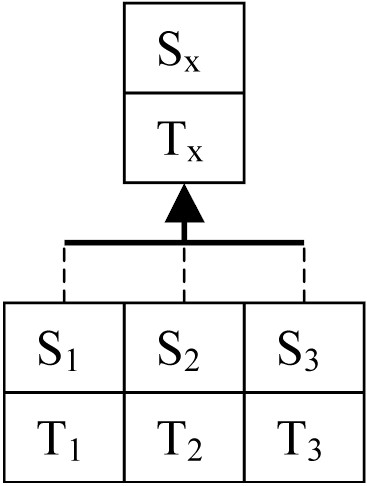 Following
this rule it means that for "Strategy entity SX" there is
also its’ own "Tactic entity TX", which describes the
action needed to be taken in order to achieve Sx.
Following
this rule it means that for "Strategy entity SX" there is
also its’ own "Tactic entity TX", which describes the
action needed to be taken in order to achieve Sx.
What is the relationship between Sx and
S1, S2, S3 ?
S1, S2, S3 are prerequisites for
the attainment of Sx.
What is the relationship between Tx and
T1, T2, T3 ?
T1, T2, T3 are
the details of Tx.
Time is not involved when we dive down a level
because to perform T1, T2,
T3 (which are the details of Tx) is to perform
Tx.
We also now understand the following:
The group S1/ T1 +
S2/ T2 + S3/ T3 ,is
sufficient for the attainment of step: Sx/
Tx
Each one of the Steps: S1/ T1
, S2/ T2 , S3/ T3
, is necessary for the
group to achieve step: Sx/ Tx
.
In our diagram the dotted lines represent
necessary connections, where the solid arrow represent sufficiency.
Let each pair of boxes Si/Ti be called a step.
Several steps in a group at one level form the necessary steps
sufficient to achieve a step at a higher level.
Whenever we go down one level in the S&T
(Strategic and Tactic) tree, it means that we should specify the
necessary steps (composed by Strategic and Tactic entities) that as a
group are sufficient to attain the higher step.
Except for the highest level, we should always
have more than one step in a group. If we have only one step in a
group, we don’t detail the corresponding higher level, but
rather write the same thing in different words.
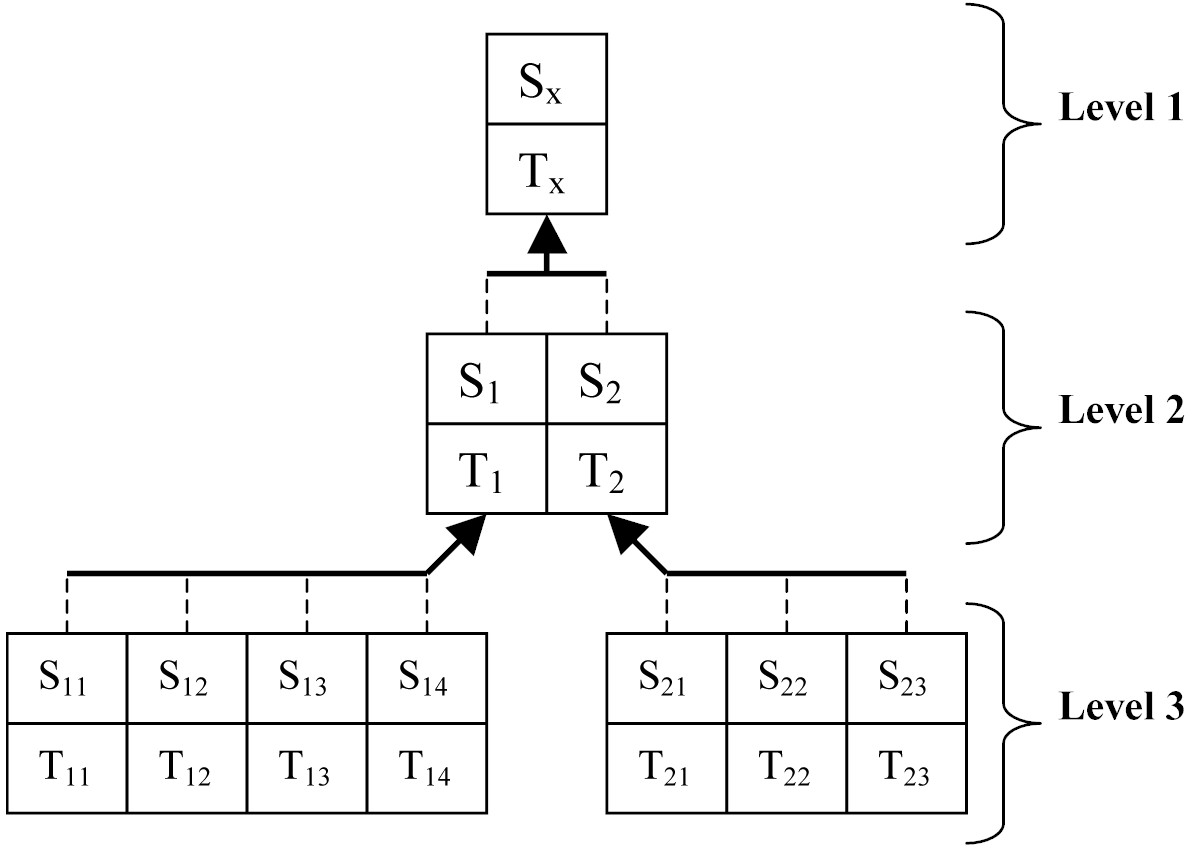 Therefore,
we have the following rule:
Therefore,
we have the following rule:
For any step, there is more then one
corresponding step in a lower level.
In the diagram an example is
illustrated:
Notice that there is no limitation on how many
steps we can have in a group.
So far, a step in a S&T tree was said to be
composed by a strategic entity (the objective) and a Tactic entity
(The action). There are other components to be added to each step,
all can be considered as explanations:
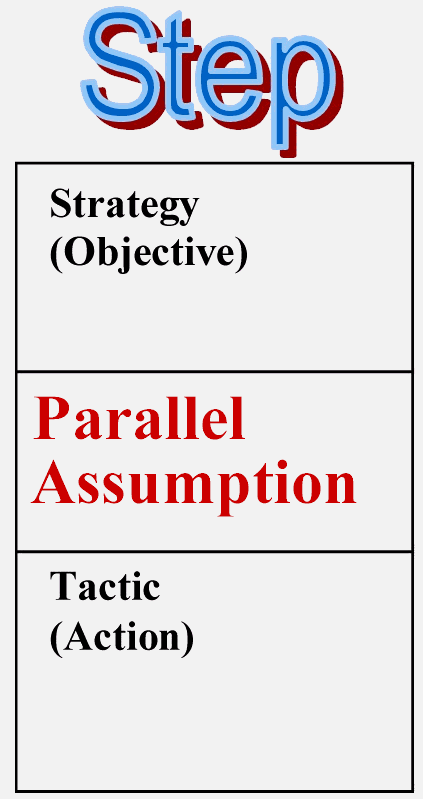 The
Parallel Assumption:
The
Parallel Assumption:
For each step we claim that the step’s tactic
(the How) will achieve the step’s strategy. The claim can be
challanged in different ways:
- There is no need for an action to achieve the
strategy.
- It is not possible to take the
action
- There is another, better
alternative
- There is a need for an additional
action.
The parralel assumption is the answer we give to
these challanges. Therefore the parralel assumption can be a
necessary assumption (reason 1) or a sufficiency assumption (reason
4) or niether (reasons 2 and3) depending on the situation.
It is possible to have several parralel
assumptions.
Tips to come up with a meaningful parralel
assumption:
- Highlight what is currently missing that
prevents the attainment of the strategy.
- Explain why nothing else besides what is
written in the Tactic entity is needed in order to achieve the
Strategy entity.
- Disqualify, less suitable, alternative
tactics.
- In case that the tactic can be challenged as a
flying pig state that it is possible (the lower level details are
supposed to substantiate your claim).
Example: The company XX is a not-for-profit
subsidery operating under budget. An initiative is launched with the
objective (strategy entity) of: "Closing the gap between what is
needed and what is budgeted for the attainment of XX objectives." The
chosen Tactic entity is: "Creating sufficient net income to close the
gap between what is needed for the attainment of XX objectives and
what is budgeted."
At first glance the tactic does not look much more
than a wishfull repetition of the objective. Notice how much clarity
is provided by the parralel assumptions:
- Cutting cost will unevoidably jeopardize XX
ability to attain ts objectives.
- There is no possibility to increase the
budget.
- There is no possibility to cut (reduce) XX
objectives.
- It is possible to generate additional
sufficient net income.
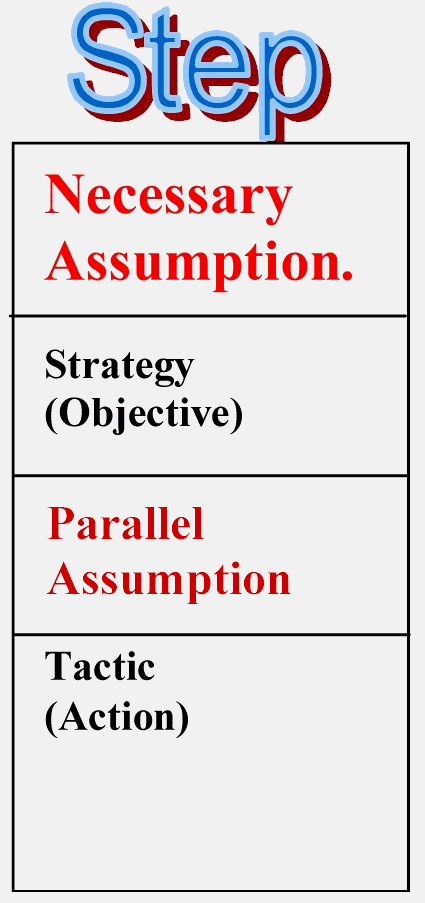 The Necessary assumption:We said that a step is necessary
to achieve its corresponding higher step. The necessary assumption
must be explicite. It explains why the given step is necessary (as
part of the group) to achieve the higher step. It is possible to
have several necessary assumptions.
Tip: To come up with a
meaningful necessary assumption: Think of someone who will claim
that this step is not necessary. Write your
reply as the necessary assumption. That will explain why it is
necessary, why this step is significant.
The Necessary assumption:We said that a step is necessary
to achieve its corresponding higher step. The necessary assumption
must be explicite. It explains why the given step is necessary (as
part of the group) to achieve the higher step. It is possible to
have several necessary assumptions.
Tip: To come up with a
meaningful necessary assumption: Think of someone who will claim
that this step is not necessary. Write your
reply as the necessary assumption. That will explain why it is
necessary, why this step is significant.
- The sufficient assumption: For each
group of steps we claim that the group is sufficient to achieve
the corresponding higher step. The assumption that substantiates
this claim must be explicite. The sufficient assumption explains
why all the steps of the corresponding lower level group, are
sufficient to attain this step.
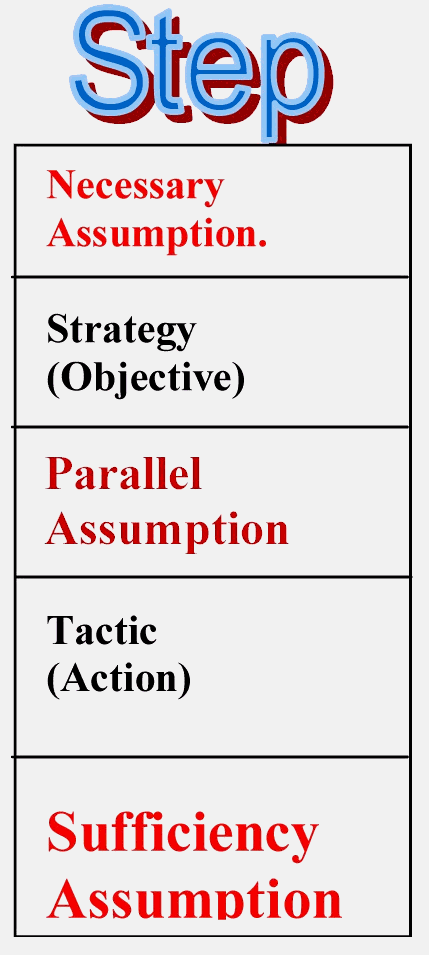 It is possible to have several sufficiency
assumptions.
It is possible to have several sufficiency
assumptions.
Tips to come up with a meaningful
sufficincy assumption
In the S&T tree we write only strategic
entities that are:
- 1. Necessary (for the group to be
sufficient).
2. An action must be taken in order to achieve
them.
Therefore,
- 1. Disqualify what someone may think is a
necessary condition.
2. Point out that a certain necessary condition
already exists,
and no action needs to be taken in order to
achieve it.
Intermediate summury
The S&T tree looks like the following
diagram:
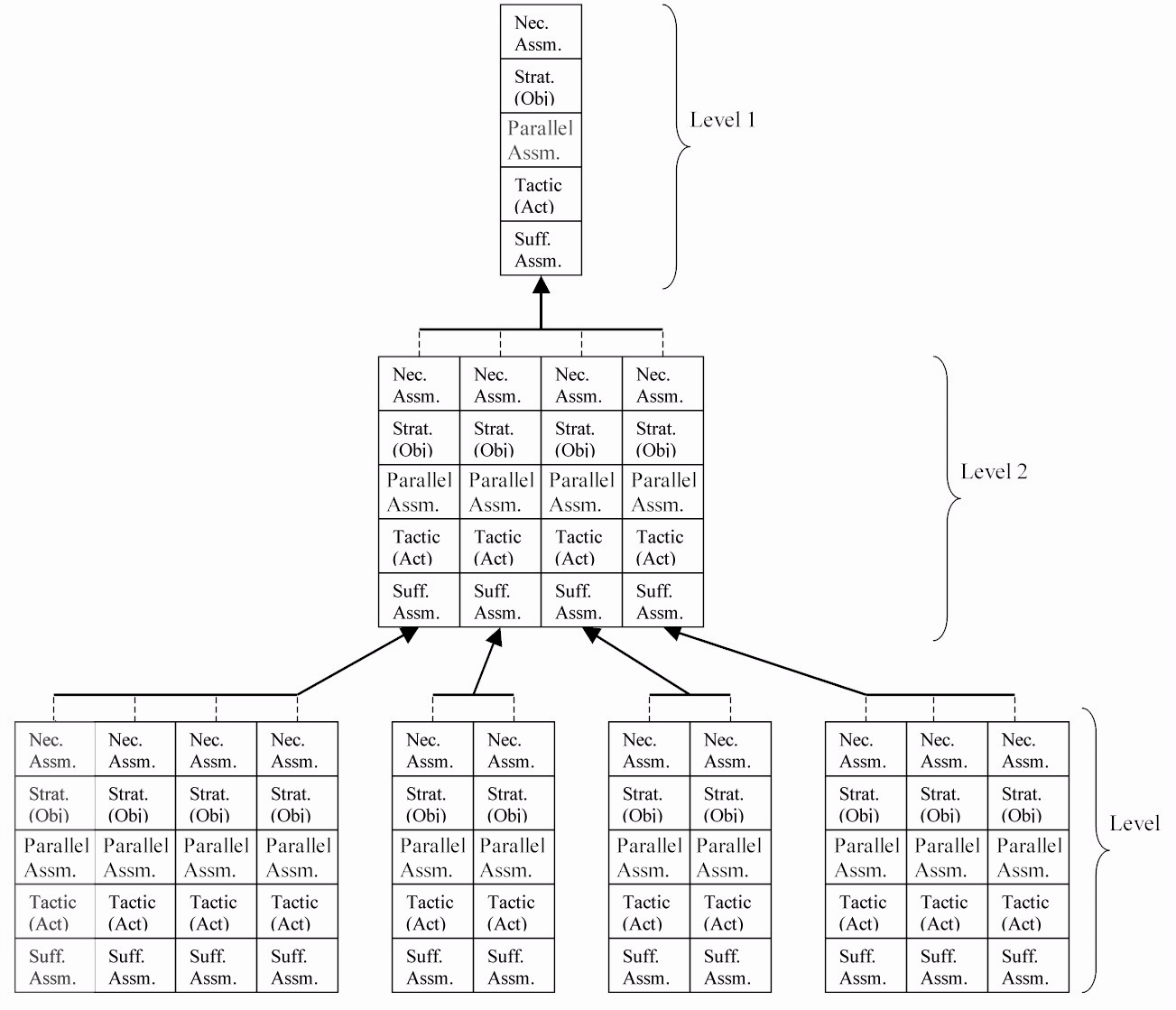 :
:
- How do we consider
alternatives?
Alternatives should not be found where there is a
necessary connection (otherwise it would not be necessary), they can
only exist when there is a sufficiency connection. Thus, there are
only two places where alternatives could be found:
Within a step, in the connection between the
"Tactic entity" and the "Strategic entity". In this case, the
alternative means that for the given Strategy there is another
alternative Tactic.
Between levels, in the connection between a lower
level group and its corresponding higher level step. In this case,
the alternative means that there is another group of steps in the
lower level, that could be sufficient for the attainment of the
higher level step.
- How do we decide if a certain step is part
of the group. A certain step is part of the group if and only
if it is necessary on its own merit for the attainment of the
appropriate higher level step. It should not be there just as a
means for achieving the other steps in the group (in this case it
belongs to a lower level group).
- Numbering. The complete S&T tree
will have many steps. If we want to be able to keep track of
things we must be able to number each step in a way that will
point out where it is located in the tree. To identify the
location of a step in the tree we need to specify which step it is
in which group of which level. Therefore, each step will be
identified by a set of three numbers.
- Multiple parents. It is possible to
kill two birds with one stone. In other words, it is possible that
a step will participate in achieving two different higher steps,
or that a group of steps will achieve two different higher level
steps. In this article we’ll no elaborate on it.
- Supporting steps. There are steps that
we would like to take not because they are absolutely necessary
for the attainment of a higher step, but because they will
contribute to the probability (or magnitute) of achieving the
higher step. Again, in this article we’ll not allaborate on
the specific mechanism to deal with such supporting
steps.
- Time dependency. This is a very
involved subject. At this stage, you don’t want to dive into
it.
Constructing the S&T tree
General Advice 1: The easiest way to go upwards,
from a a lower step into a (yet not writen) higher level, is to
concentrate on the Strategy entity (of the lower step) and ask, "Why
do I want to accomplish this objective? I must accomplish this
objective in order to… ." Compliting the answer will provide the
Strategy of the higher level.
General Advice 2: The easiest way to dive into a
(yet not writen) lower level is to concentrate on the Tactic entity
of the higher level and ask, "How exactly should this action be
performed?" The answer will provide the Tactics of the lower
group.
Start to build your S&T tree
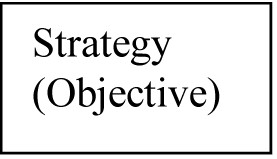 Using
the above advice it is clear that conceptually one can start to write
a tree from any step at any level. Still, it is recommended to start
by verbalizing a high level objective (Strategy entity). It
doesn’t have to be the highest one, but it should be among the
higher levels.
Using
the above advice it is clear that conceptually one can start to write
a tree from any step at any level. Still, it is recommended to start
by verbalizing a high level objective (Strategy entity). It
doesn’t have to be the highest one, but it should be among the
higher levels.
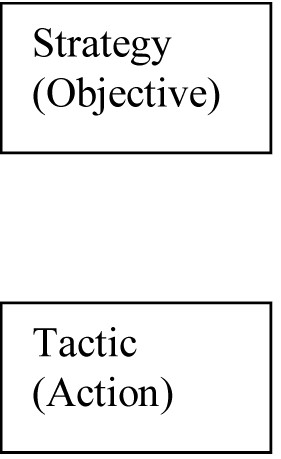
In order to come up with a starting high level
objective, ask:
- What is the purpose of the subject/system in
question?
- What is the reason for its
existence/establishment?
If you come up with more then one objective (and
none of them could be considered as just a means for the other) then
you should put them as two (or more) Strategic entities of two
distinct steps (probably of the same group).
Completing the step
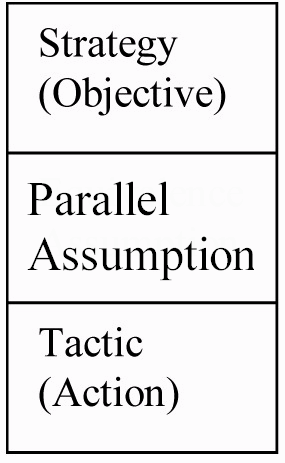 You
need to verbalize the "Tactic entity" for the given "Strategic
entity".
You
need to verbalize the "Tactic entity" for the given "Strategic
entity".
Ask: What is the action that satisfies this
objective?
Make sure the action you write is sufficient for
the attainment of the "Strategic entity".
Verbalize the parallel assumption, which explains
why did you choose the "Tactic entity" you’ve written for the
attainment of the "Strategic entity".
In order to come up with a meaningful parralel
assumption(s) it is possible to:
Either explain why nothing else besides what is
written in the Tactic entity is needed in order to achieve the
strategy entity and/or disqualify less suitable alternative tactics
and/or ensuring that it is possible to perform the tactic.
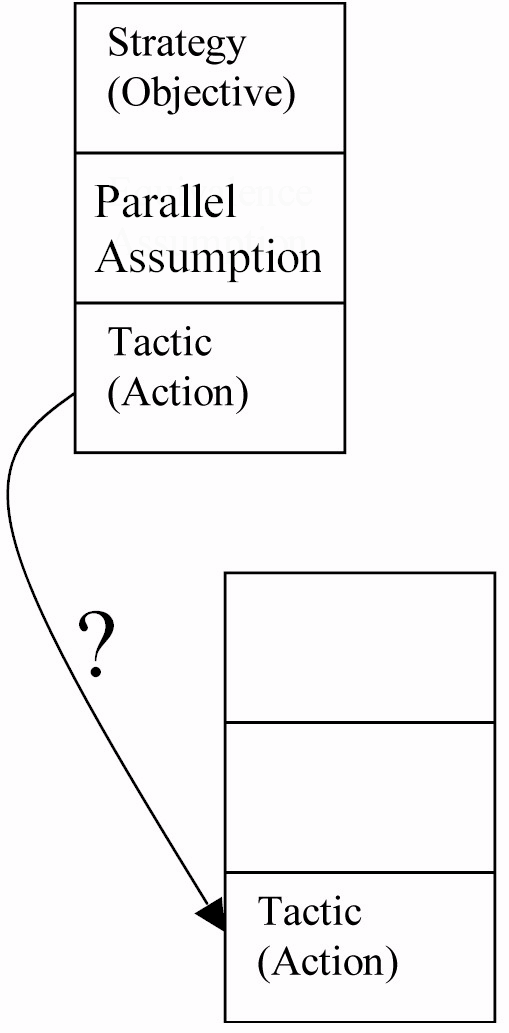 Diving
down
Diving
down
To dive down, go down a level through the Tactic
entity - Ask:
- What actions should be taken in order to
achieve this Tactic?
- How do we take this action?
You must come up with more than one action. Any
action that is necessary on it’s own merit (and not just as
means for the other actions) should be written as a "Tactic entity"
of one of the steps in the lower level group.
Verbalize the "Strategic entity" associated with
each given "Tactic entity". Ask: What is the specific objective
attained by taking this tactic action?"
Make sure the action is sufficient for the
attainment of the "Strategic entity" you wrote. If it is not
sufficient take that as a clear indication that you verbalized a too
high of an objective. Try to be more specific in your strategic
entity.
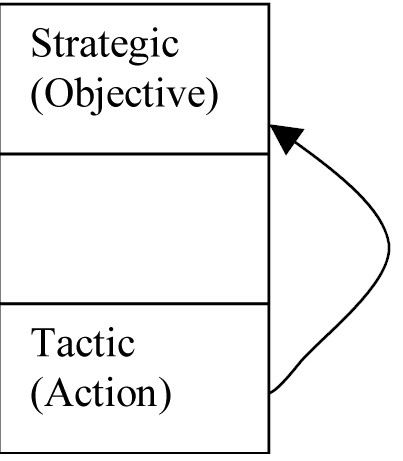
Complete the verbalization of the parallel
assumption in each one of the steps in the group.
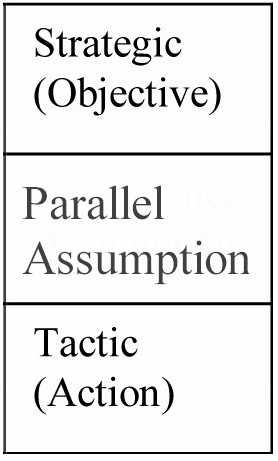
Completing the connection between the
levels
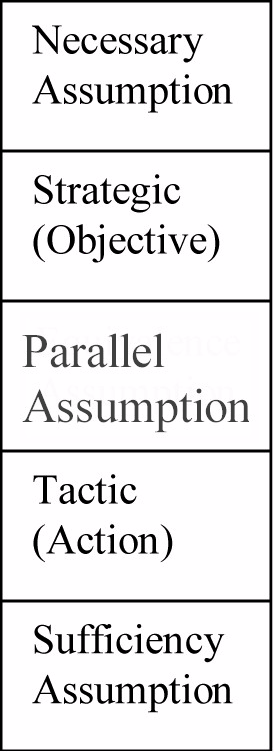 Verbalize
the necessary assumptions of each step.
Verbalize
the necessary assumptions of each step.
Examine the Strategy entity and answer the
following questions:
"Why is achieving this objective necessary for
achieving the higher step?"
"Why if this objective does not exist that the
rest of the group will not be sufficient to achieve the higher
step?"
Think of someone who will claim that this step is
not necessary.
Write your reply as the necessary
assumption.
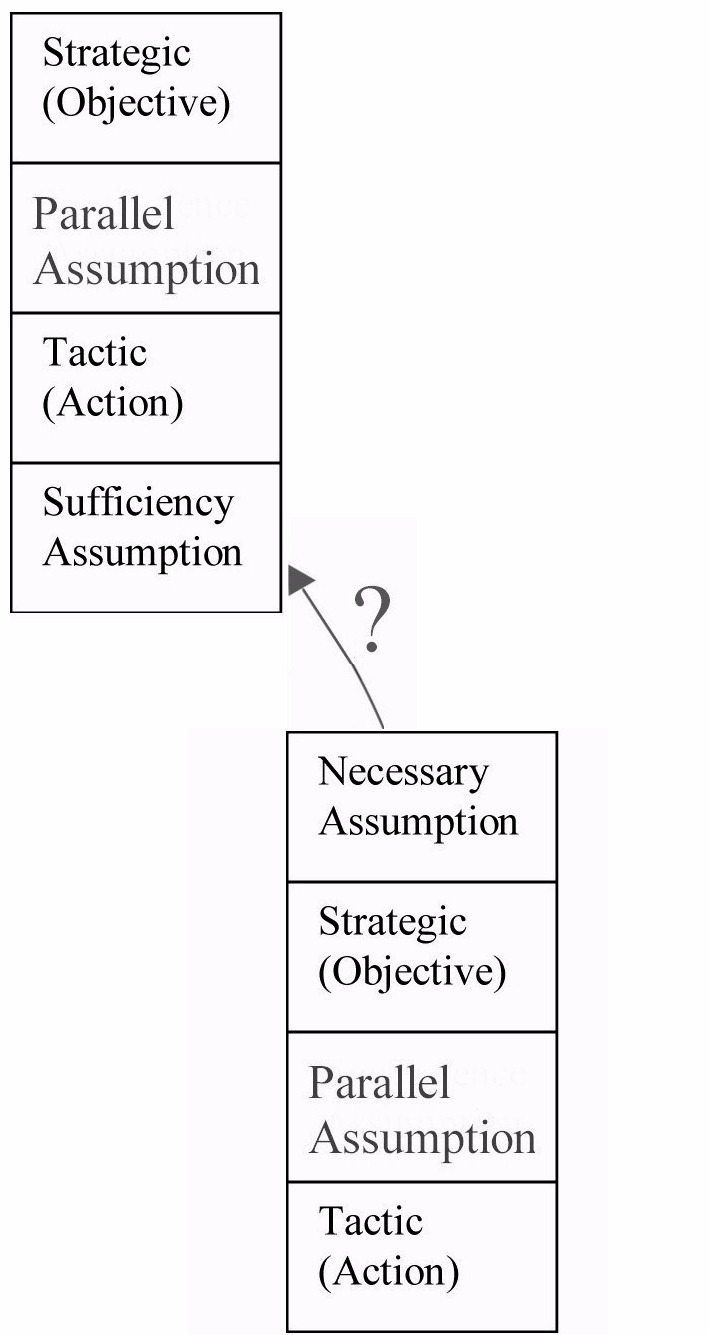
Go back to the appropriate higher step and
verbalize the "Sufficient assumption". In order to come up with a
meaningful sufficiency assumption it is possible to disqualify (or
reject) what someone else thinks is a necessary condition.
And/or point out that the necessary
condition is already sutisfied and no additional action need be taken
in order to achieve it.

Follow the process until you reach a level which
subjectively seems to you detailed enough. Most probably your boss
will be under the impression that you’ve dived too deep (having
too much detail) and your subordinates will have the impression that
you haven’t dived deep enough (didn't provide enough detail). If
this happens, it is good. It is an indication that the S&T tool
is the appropriate tool for deligation and empowerment.
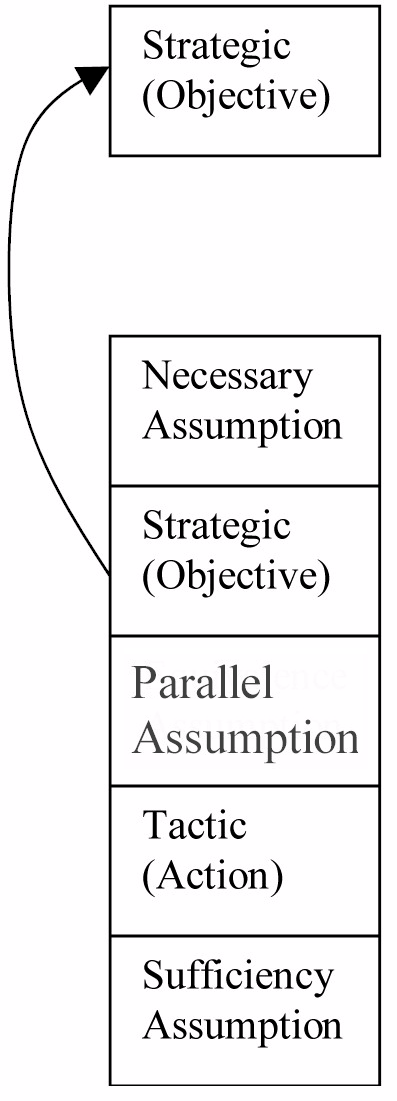
Going up a level
You might have started with a step that is not the
highest step. To complete the tree you’ll have to construct the
higher levels. Going up a level is done "with a purpose in mind". In
other words, you should examine the stragtegy entity of the step(s)
and ask, "What is the objective of achieving it?" The answer will be
the strategy entity of the higher level. When the higher step is
completed make sure that the corresponding group at the lower level
is sufficient for its attainment.
How do we read a S&T
tree?
When reading your tree to someone who didn’t
write it with you it is recommended to adhear to the following
process. Start at the top. when you dive a level:
- Read all the Necessary assumptions of the
different steps in the lower group.
- Read (again) the Necessary assumption with
it’s corresponding Strategic entities of each
step.
- Read the Sufficient assumption of the higher
step.
- Read (again) the Strategic entity with
it’s corresponding Tactic entity and parralel assumption of
each step.
Copyright Eli Goldratt 2002
(This document was released to Washington State
University for EM 596 Contemporary Topics in Constraints
Management. Eli asked me to post this document for the world to see.
Enjoy! Dr Holt jholt@wsu.edu
 What
we now realize is that strategy is not just a statement or a
collection of statements but it has a hierarchical structure. There
are several levels of strategy connected by necessary conditions -
objectives from a lower level are prerequisites for objectives in a
higher level. We expect that higher objectives will be generic in
type, while objectives from lower levels will tend to be more and
more specific.
What
we now realize is that strategy is not just a statement or a
collection of statements but it has a hierarchical structure. There
are several levels of strategy connected by necessary conditions -
objectives from a lower level are prerequisites for objectives in a
higher level. We expect that higher objectives will be generic in
type, while objectives from lower levels will tend to be more and
more specific. These
"necessary ingredients" are actually the unique objectives attained
by taking each one of the "Tactic entities". To conclude, The basis
for a claim that several "Tactic entities" (T1,
T2, T3) are needed for
the
These
"necessary ingredients" are actually the unique objectives attained
by taking each one of the "Tactic entities". To conclude, The basis
for a claim that several "Tactic entities" (T1,
T2, T3) are needed for
the Following
this rule it means that for "Strategy entity SX" there is
also its’ own "Tactic entity TX", which describes the
action needed to be taken in order to achieve Sx.
Following
this rule it means that for "Strategy entity SX" there is
also its’ own "Tactic entity TX", which describes the
action needed to be taken in order to achieve Sx. Therefore,
we have the following rule:
Therefore,
we have the following rule: The
Parallel Assumption:
The
Parallel Assumption: The Necessary assumption:We said that a step is necessary
to achieve its corresponding higher step. The necessary assumption
must be explicite. It explains why the given step is necessary (as
part of the group) to achieve the higher step. It is possible to
have several necessary assumptions.
Tip: To come up with a
meaningful necessary assumption: Think of someone who will claim
that this step is not necessary. Write your
reply as the necessary assumption. That will explain why it is
necessary, why this step is significant.
The Necessary assumption:We said that a step is necessary
to achieve its corresponding higher step. The necessary assumption
must be explicite. It explains why the given step is necessary (as
part of the group) to achieve the higher step. It is possible to
have several necessary assumptions.
Tip: To come up with a
meaningful necessary assumption: Think of someone who will claim
that this step is not necessary. Write your
reply as the necessary assumption. That will explain why it is
necessary, why this step is significant. It is possible to have several sufficiency
assumptions.
It is possible to have several sufficiency
assumptions. :
:
 You
need to verbalize the "Tactic entity" for the given "Strategic
entity".
You
need to verbalize the "Tactic entity" for the given "Strategic
entity". Diving
down
Diving
down

 Verbalize
the necessary assumptions of each step.
Verbalize
the necessary assumptions of each step.

